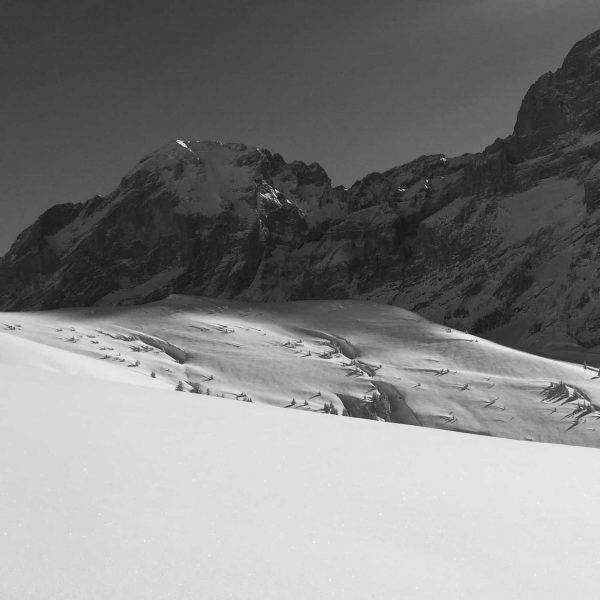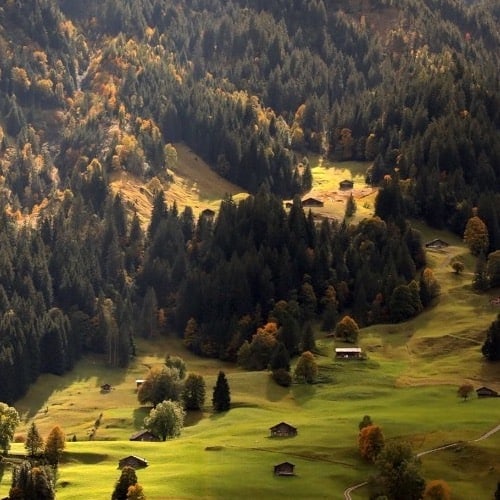This post explores the notion of displacement through the experience of Franziska, who has spent her whole life in a peaceful touristic village of the Swiss Alps. I argue that her experience of displacement can be explained through conflicting temporalities.
“To live where others spend their holiday”, says Franziska admiring the breath-taking panorama on the Swiss Alps before telling me what a luxury she thinks this is. It is a perfect winter morning of February; the sun is high and the snow is fresh. We are sipping our coffees on the terrace of a winter ski bar between two ski descents. It is still early and we’re almost alone. The crowd of skiers is probably about to arrive but, for now, I also feel privileged.
Franziska is a local woman from a touristic village at the foot of these mountains, the place where I have conducted fieldwork for a year[1]. Now in her late 40es, she was born a couple of kilometres further down the valley and has been living here her whole life. The idyllic depiction Franziska gives me that morning sounds familiar. Firstly, because she is a genuinely joyful and positive person who never gets bored with this view, and secondly, because I have read similar touristic slogans on advertisement boards in virtually every cable car, bus or train I have travelled within the region. Later that day, however, she describes another reality: that of feeling lonely and suffering from a lack of social connections in the village, despite her deep affection for the place she has grown up in and a house she has been cherishing for the past twenty-three years.
At first, the difficulties she encountered with building and maintaining relationships in the village over the years came as a surprise. While I had been warned early on that the locals were right-wing conservative, “cold and not easily approachable mountain people”, I did not expect them – probably naively – to suffer from this distance too.
This post explores how feelings of displacement can occur in a context that is nonetheless not solely defined by outburst of violence, forced exile, migration and spatial movement.
Instead, I propose to examine other facets of the experience of displacement through the accounts of one local woman living in a picturesque and peaceful touristic village in the Swiss Alps. More precisely, I will stress the role of temporality in her experience.
As a first step, let me go back to my naive expectations of finding a strong social community in my fieldwork location. I now believe it was in fact not just naïve; it was rooted in an imaginary of the Swiss Alps as the epitome of Home. To fully understand the implications of such discourses for Franzika’s experience, I will provide a brief historical overview on how the Swiss alpine landscapes became home for international tourists and nationalists.
Back in the 17th century, scientist Johannes Hofer theorized the concept of homesickness or Heimweh to describe the illness of Swiss soldiers abroad, longing for their homeland. When hearing a Swiss shepherd song called the Kuhreihen, the soldiers would be reminded of the place and the life (as peasants) they had left behind and fall into deep sadness (Lems 2016). According to Hofer, only a return to the Swiss Alps could cure this potentially deadly pathology.
For the two next centuries, Romantic artists and authors’ use of Heimweh mirrored their own understanding of nostalgia. No longer symptomatic of an illness caused by displacement, nostalgia became a sign of the modern times and a positive reaction against the galloping industrialization processes taking place in Europe.
The figure of the Swiss soldier became that of a rebel, deeply bounded to place and traditions in a world of movement and discontinuity (Lems 2016:7). This contributed to a mythification of the Alps as a place of resistance, where one could reconnect with Nature in its purity. The valleys that saw their inhabitants leave for war in the 17th century welcomed their first[2] Romantic tourists in the 18th century. Voluntarily leaving their own urban and industrialized homes, they sought for experiences of the Sublime in the Alps, where they believed Man truly and naturally belonged. Ironically, this paved the way for further technological progress with the industrialization of tourism in the Alps. At the turn of the 20th century, Switzerland’s peaks had become touristic hotspots, usually accessible by train and/or cable car.
In the 1930s, in response to the rising nationalism of its neighbours, Switzerland’s alpine identity was no longer synonymous with hospitality but hostility (Zimmer 1998). Hotels welcoming tourists were now hosting soldiers as part of the national defence strategy and guests turned into potential enemies[3]. Mountains became barricades, standing physically and metaphorically against the German invader. Not only did the Alps serve as a unifying force against external threat but also as a means to maintain social cohesion in a country with no ethnolinguistic nor political commonality and transformed unevenly by industrialization processes. Building up on Romantic ideals of natural purity, the mountains were increasingly perceived as a conservative safeguard against modernity and its abuses, such as “cosmopolitanism and foreign immigration” (Zimmer 1998: 665). The word Heimat – approximately translated as “homeland” in English – gained popularity, especially in the context of Nazi Germany.
Between feelings of love/loss, patriotism, nationalism, political propaganda and administrative categories, the concept of Heimat is not easily definable and still debated nowadays.
However, its political use and especially calling for its protection and preservation has often legitimized exclusion of those perceived not to belong in it, in Switzerland as well as in the rest of the German-speaking world until today (Groebner 2017). The Alps have often stood for Swiss identity, traditions, a certain idea of resistance, security and freedom, and, in political discourses and popular imageries, as a symbol of Heimat. A Heimat in which not everyone is welcome. Even less so with the rise of the now strongest political party of Switzerland – the far-right Swiss People’s Party (SVP) – which has been posing immigration as a threat for the past four decades. Historically popular in the Alpine regions of the Swiss German part, like Franziska’s village, the SVP has coexisted with a successful hospitality industry that has been welcoming tourists from all over the world until today.[4].

During more than two centuries, artists, scientists and politicians theorized ideas of nostalgia, Heimweh and Heimat around the landscape Franziska and I were looking at from the ski bar’s terrace on that morning of February. While she did not express any feelings of homesickness, I came to realize that being in her homeland, her Heimat and at home, did not mean that she was not longing for another idea of home. To make this point clearer, I have to shed light on the objects of Franzika’s yearning.
Franziska and I are chatting in her kitchen. The walls are covered with posters of Swiss mountains and Edelweiss flowers (the national symbol). After a while, she confesses that she genuinely wishes she had lived in the past, in a previous era she has never even witnessed. She would have liked to live before tourism appeared in the region, to experience something different from the “fast, non-committal, hurried times” (schnelle, unverbindliche, hetzige Zeit), as she puts it. Franziska feels lost in a world of increasing technology and fast mobility “where one can take his car and leave anytime if he feels like it”. Building long-term, meaningful relationships in that context seems not to be possible nor important for others, even superficial. But not for Franziska, who does not like the current atmosphere in the village: “We’re anonymous to each other”.
By looking back to the past, she does not simply formulate a critique of the fast-paced contemporary society.
In pre-tourism times, her ancestors were also much poorer, which, in her opinion, is synonymous with greater solidarity and social cohesion. “People are doing too good now”, she regrets. On many occasions, Franziska criticizes the greediness of her fellow villagers and how tourism has improved their financial situations but also dismissed the necessity for them to come together. For her, like other inhabitants of the valley, tourism is the only mean to secure a living but this does not come without sacrifices: “Tourism and the constant coming and going of tourists has probably made locals unruhig (restless, uneasy, anxious)”. The arrival of “seasonal workers” from Portugal has complicated things too. Franziska regrets that they did not make efforts to “integrate” nor learn the language, which makes communication almost impossible. Even though she knows that many of them have been here for the last twenty years and have learned Swiss German, she still calls them “guest-workers”, like the rest of the locals do. Maybe in the hope that they will leave again.
Contrasting with the uneasiness and problems brought by tourism, she tells me about a motive often celebrated in traditional Swiss folk music called the Bänkli vor em Hüsli (the little bench in front of the little house): “In front of my little house, there is a small bench, where I used to play as a little boy. (…) And a neighbours’ pretty little daughter was often sitting next to me. (…) And the little girl is now my wife”[5], goes one of the yodel songs. As if Franzika had been there too, once a long, long time ago or in a distant dream, she describes how people would often go to their neighbours, sit on the bench and chat for a while, “because they didn’t have a TV back then”. If not for romantic relationships, like in the song, the Bänkli stands for the possibility to tie authentic, long-lasting bonds, which, Franzika feels, has gone lost.
The discussion goes on and, as I mentally wander with her through the nostalgic depiction of a premodern Switzerland, she suddenly radically changes direction. She tells me about the need to build new cableways that enable the tourists to reach the peaks faster and will secure the leading position of her village on the very competitive marketplace of mountain tourism. “We have overslept”, she says, in the words of a tourism lobbyist I have read in the local newspaper. They have to catch up with time, otherwise “tourism will disappear” and the future of the region with it. The rosy pictures called up by Franziska’s nostalgic dreams have now faded away. I imagine the fastest, latest cable cars going through landscapes that locals nonetheless call their “capital”. The new project is needed for the whole valley and for the future of the inhabitants’ kids. And for those thinking that now is enough, tourism actors warn not to not trust appearances: “The greatest threat to your future success is current success”. Franziska is convinced that the new project is better for the common good but admits not needing it personally. “I am scared by the dimensions of the project”, she concludes, “but it is needed”.
The numerous conversations I had with Franziska have often left me confused. Making her best to explain what disturbed her in the village and why she felt so lonely sometimes, she would usually target two tendencies that I only was able to identify retrospectively: on the one side, she was hurt by the “narrow-mindedness” and suspicious attitude of her fellow villagers towards everything “new and different”; on the other, she was puzzled by the fast pace of tourism and technology, overwhelmed with the numbers of tourists and the constant pressure to make more money and build more. Franziska was suffering from the villagers’ judgmental attitude, who would perceive her as lazy and remind her of her abnormality because she didn’t work[6]. She often felt left out for reasons she couldn’t understand. But, when hoping for more tolerance, she would adopt a neoliberal posture, stating that this narrow-mindedness also stood in the way for the hospitality industry’s success. However, standing behind tourism also meant accepting its negative effects on the village, and Franziska couldn’t. She would almost naturally end up criticizing the bad behaviour of Asian “mass tourists” or immigrant “guest-workers”, reproducing what she was denouncing first.
There was no alternative to social conservatism or neoliberalism and she was lost in their contradictions.
Unlike the Swiss soldiers in the 17th century, her experience of displacement was not associated with spatiality but, rather, temporality. Squeezed between memories of a past that resembled that of the nationalists’ lost Heimat and the short-term future promoted by touristic technocrats, the space left for a real consideration of the present seemed very small. Too small for Franziska to build friendships at least. If, according to Benedict Anderson (1983), the perception of a simultaneous, homogeneous time is an essential feature of the “imagined community”, Franziska’s struggles to find a common temporal frame in which to live and to interact with her fellow villagers, tourists and guest-workers helps to understand her experience as temporal displacement. And she was not the only one to feel that way.
References
Anderson, Benedict. 1983 (2006). Imagined Communities. Verso.
Groebner, Valentin. 2017. Vorrecht: Über die Geschichte und den Presis eines Scheins, in Stapferhaus Lenzburg (ed.) Heimatland, eine Grenzerfahrung, 148-159.
Lems, Annika. 2016. Ambiguous longings: Nostalgia as the interplay among self, time and world. Critique of Anthropology 0(0): 1-19.
Zimmer, Olivier. 1998. In Search of Natural Identity: Alpine Landscape and the Reconstruction of the Swiss Nation. Comparative Studies in Society and History, 40(4), 637-665.
[1] In order to protect my main informant, I have decided to anonymize her name and not to mention the name of my fieldwork location. My doctoral thesis is part of a project funded by the Science National Swiss Foundation under the supervision of Prof. Sabine Strasser at the University of Berne. My colleague, Dr. Paul Reade, is conducting fieldwork in Mexico as part of the same project.
[2] Johann Wolfgang von Goethe being one of the first, along with Jean-Jacques Rousseau for instance.
[3] Etymologically, the words “hospitality” and “hostility” share the same roots, both deriving from the Proto-Indo-European ghos-ti-, just like the words “host”, “guest”, “stranger” and “enemy”: https://www.etymonline.com/word/*ghos-ti-
[4] Not without conflicts. The Swiss tourism industry has faced some criticism for accepting guests from the Middle-East wearing niqabs.
[5] “Vor mim Hüsli, da steit s Bänkli, ha viel as chliine Bueb da druf gspielt (…) und a Nachbur, sis herzig Meitli hat sich viel zu mir aufs Bänkli gsetzt. Und das Meitli isch hüt mis Fraueli”: https://www.youtube.com/watch?v=AK4L7TtMeMs
[6] She had stopped working after having her children and never started again. In the village, most of women and men were involved either in farming or tourism. She was not.





